Yesterday it was a month ago that I returned from my trip to Switzerland. It is hard for me to believe it is only a month… it feels like it was eons ago! Before my memories of this pilgrimage fade much more, I want to write about two more visits to places of importance to Anabaptist history. Today I will write about another Anabaptist hideout, and in my next post I will write about my visit to Schleitheim.
I promised that I would write about my visit to the well-known Täuferversteck (Anabaptist hideout) in a place near the town of Trub, called the Fankhauser Farm. A descendant of the people who lived at the farm during the time it was a hideout is living on the farm with his family. Simon Fankhauser and his wife, Regula, don’t usually offer tours in the wintertime, but the Kochs’ neighbor, Elizabeth, knows Regula, and so we were invited to come over. It was quite an adventure getting up their steep driveway, and we couldn’t have done it without a four-wheel drive vehicle!
Regula made us feel right at home when she invited us to have tea and a torte she made for the occasion. And there, at her kitchen table, she told us the story of the farm, and how the barn became a hiding place for the Anabaptists.
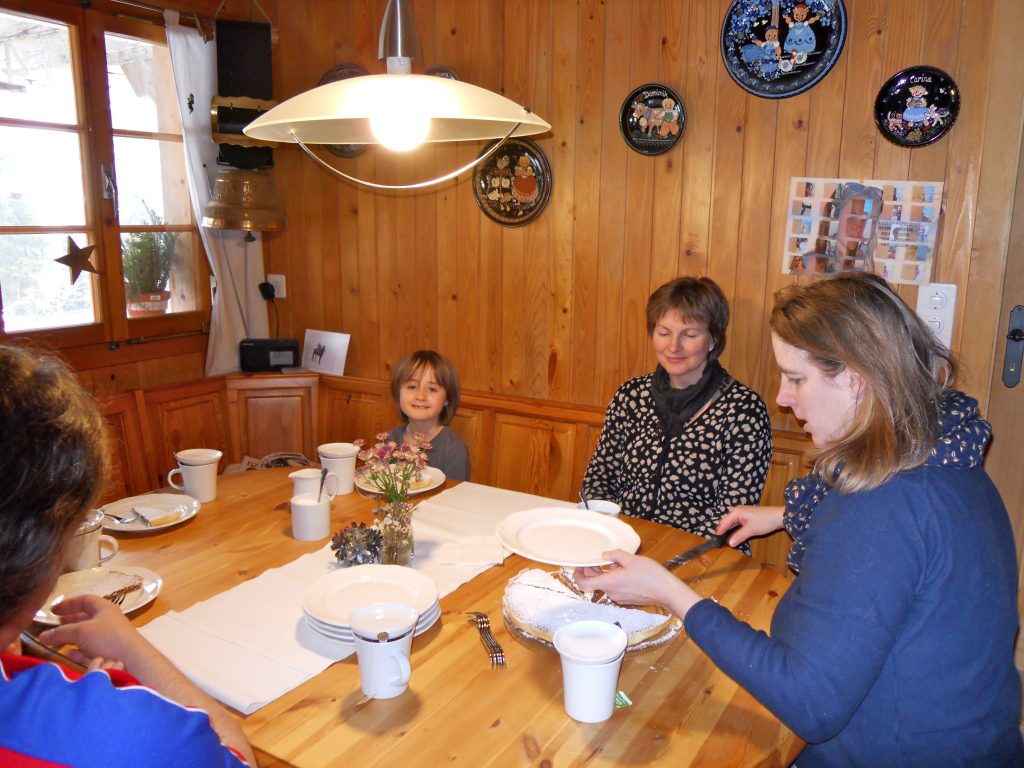
Regula serving her torte… Elizabeth to her right, and beautiful young Hadassah to her right.
First we had to establish which language she should speak in… Swiss German, and have someone translate for me; English, which would have been hard for Elizabeth to understand; or High German, which I thought I would be able to understand, and that Marco and Miriam would translate later if I didn’t pick it all up. So I chose High German. At some point I realized that I wasn’t understanding everything that Regula was saying. Marco and Miriam were distracted with the children and didn’t hear everything either. So I’ve been in touch with Regula via email to clarify some of the things she told us that day.
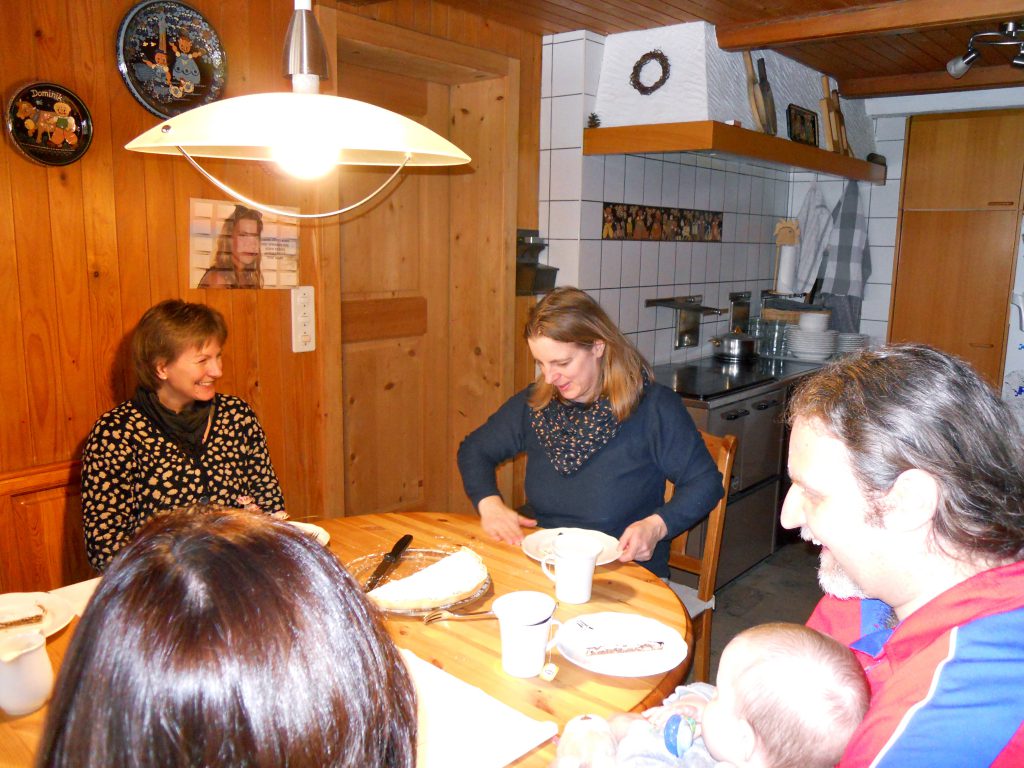
I caught people laughing at something Regula was saying…
The history of the Fankhauser farm starts with the Waldensians. From the style of the buildings, they know that a Waldensian family built it. They have not been able to prove whether Simon is a direct ancestor to this family, but they believe so. Regula paused to ask if I am familiar with the Waldensians before going on to tell me that she has been helping someone named Paul Hostettler with his research. He is searching the archives in Bern to possibly establish a connection between the Waldensians and the Reformation movement in Europe. As Regula wrote in an email to me:
For him and for me it’s clear, that the beginning of the Anabaptist movement was long before the Reformation happened. The belief is something so personal, that people out in the “fields” as we are, was not something that happened by one day or in such a short time. Why did the pastors say, even before the Reformation, that nearly all the farmers in the Emmental know the Bible by heart? That was because of the hiking preachers of the Waldensiens! Anabaptist (Täufer) was just a title for the people who didn’t go to the Reformed church; those who came together in their houses and refused to join the military. They called themselves the brothers and sisters in Christ by following the Bible, helping the poor people and those who where sick or had financial problems. They shared their lives together. Easy like Jesus did and showed us in the Bible with the first apostles.
Regula said it was through this research that she became a believer. When I was looking her name up online, I found this story about her and her husband published in the Mennonite World Review.
The paths of the Waldensians and the Anabaptists (or Swiss Brethren) diverged at some point. Many of the Waldensians attended the Reformed church and so there are few extant records of them. Because many of the Swiss Brethren refused to attend Reformed church services, have their babies baptized, swear oaths, or join the military, they continued to be persecuted by the church and government authorities (there was no separation between the two).
John Roth wrote in the preface of the book, Letters of the Amish Division that the authorities in the Zürich area had a systematic approach to their suppression of the Swiss Brethren movement. At some point, their efforts had largely eradicated the movement in the urban areas, but it drove the people into small hamlets and villages of the Bernese Oberland and the Emmental Valley. The Bernese government was much more sporadic and inconsistent in their approach, and they didn’t keep records as well as the government in the canton of Zürich did. So the Swiss Brethren in the Emmental Valley never knew when the Bernese government would next send out their “Anabaptist hunters.”
Regula said that there were strategies that the Swiss Brethren created to throw the hunters off their course. They began naming their sons by the same first name each year, and they gave the farms the same name to throw the hunters off base.
The Swiss Brethren also found or created hiding places. The Fankhauser’s barn was one of them. This hiding place was so clever, that the hunters could not figure it out. They would see someone going into the barn, but then when they went in with their pitchforks, sticking the hay in the haymow, trying to find someone hiding, they couldn’t find anyone. That is because someone had created a trapdoor that would open up if a person stepped on it. Once inside, they would bar the door from underneath, so that the authorities would not discover where they were. When there was a search going on, the people hiding would have to stay absolutely still — a cough or a sneeze could give them away.
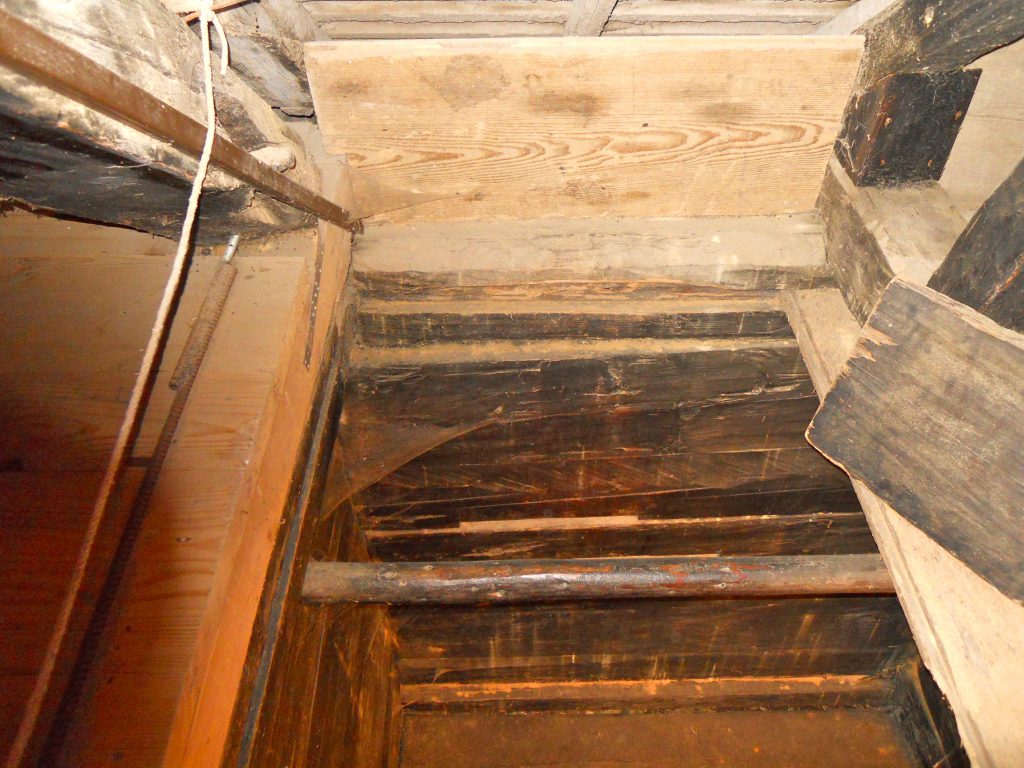
A photo of the hiding place: Photo by Saloma Furlong
The Fankhausers have a model of the building that shows how this is hidden behind the room in the floor below where they would store smoked meats. It’s rather hard to see the details in this photo, but I will include it:
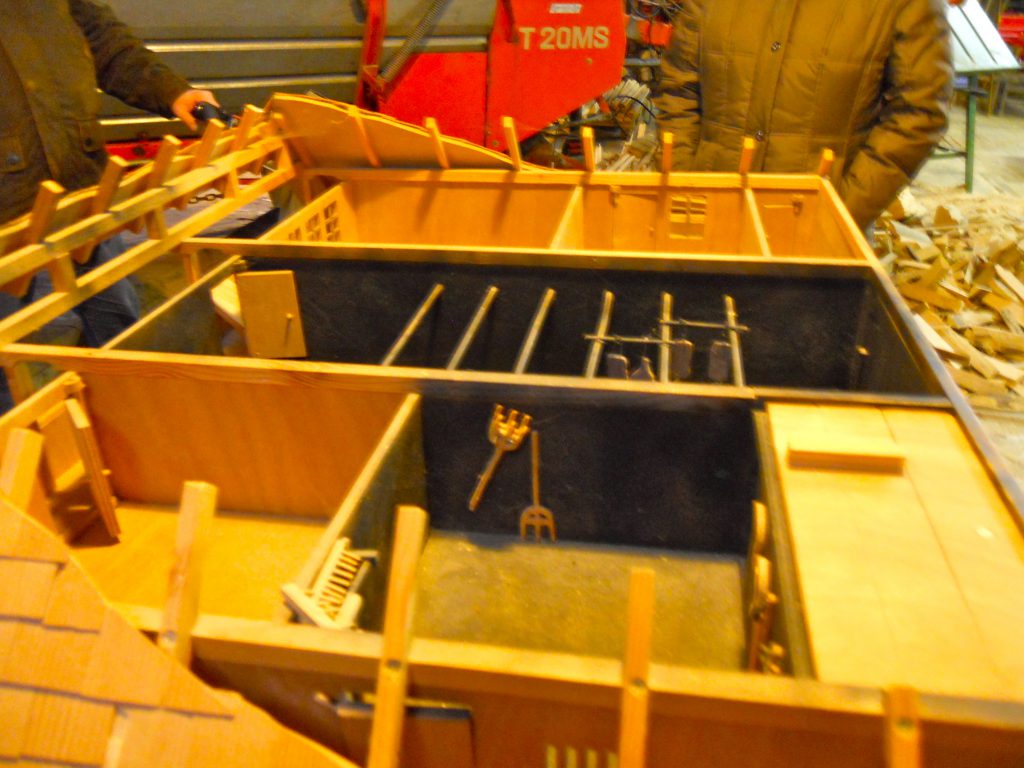
Model of Täuferversteck: Photo by Saloma Furlong
The hiding place is on the far right in that dark middle section, just to the right of the bars where the meat hangs. You can see the door where you enter into the room with the meats, and if you walk into that room, there is no way to know that the space behind the far wall isn’t the outside wall of the barn. Here is a photo of that room:
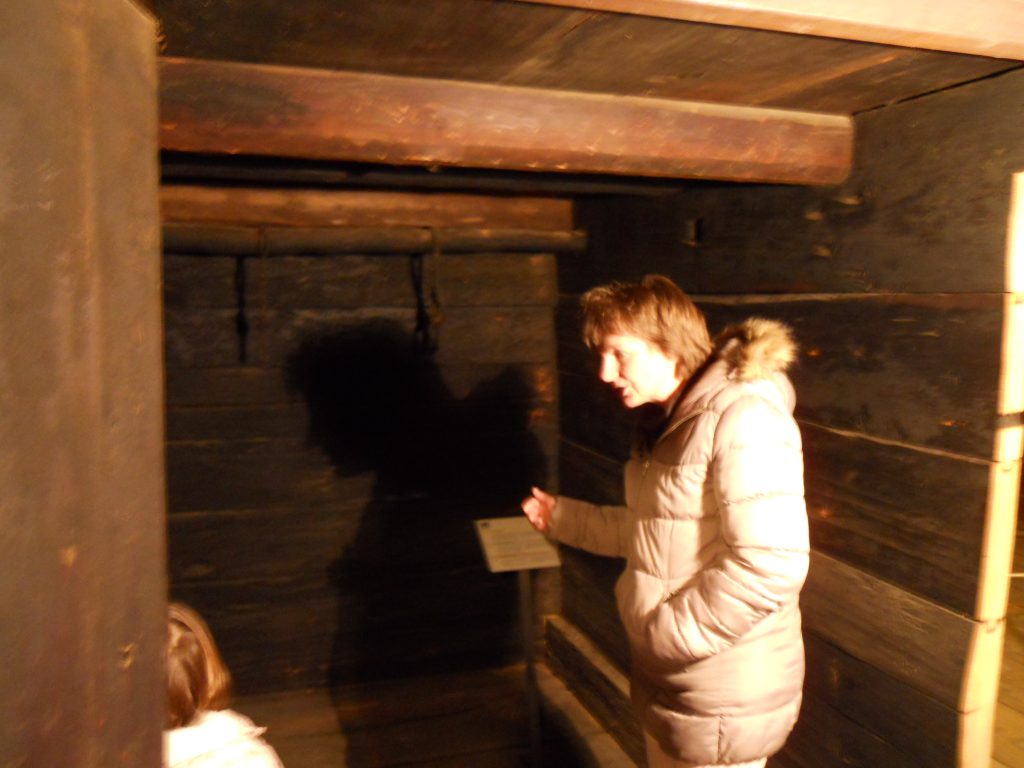
Elizabeth explaining the hideout to Hadassah
When I was growing up, I often heard the stories of how our ancestors were persecuted for their beliefs, including their hideouts in barns and caves. I had no idea, back then, that I would one day be able to visit the homeland of my ancestors and be able to visit these sites. I also had no idea that there could be a connection between one of my favorite books of all times, Paula the Waldensian, and my own heritage. There is something very exciting about discovering connections like this in some of the most unlikely places.
The Waldensians have a deep history, started by Peter Waldo in 12th century in Lyons, France. He was a wealthy merchant who gave away all his belongings and began preaching about apostolic poverty. Waldensian teachings soon came into conflict with the Catholic Church, and that is how the long history of Waldensian persecution began.
One of the mysteries for me is why many of the Mennonite researchers of Anabaptist history play down the possibility of a Waldensian/Anabaptist connection. In fact, most of them want to claim there is no connection, and they hold fast to the idea that the Anabaptist movement began in January 1525 in Zürich when adults began baptizing one another, and that this movement spread into other areas of Switzerland (and later to other parts of Europe before many of them emigrated to colonial Pennsylvania).
The Waldensians were mostly common folk, and therefore were often marginalized in history. There is a professor, Ernest Benz, at Smith College who teaches the theory that the history of common people is just as important as written history, which normally centers around those who hold power. I feel like this relates to the history of the Waldensians. What if they laid the groundwork for the learned and wealthy Martin Luther to come along and confront the Catholic Church by tacking the articles to the door of the Wittenberg Church? What if the Waldensians influenced Zwingli, who eventually became the leader of the Reformed church? And what if the three who are credited for “starting” the Anabaptist movement by baptizing one another in January of 1525 were influenced by the Waldensians?
Delbert Gratz, in his book, Bernese Anabaptists, explores the idea of a Waldensian/Anabaptist connection, but he claims the lack of records neither proves nor disproves this theory. Like Regula, he claims that the Anabaptists’ vast knowledge of the Bible was not gained through the preaching of the ministry, but resembled the traveling Waldensian minister who often knew the greater share of the New Testament from memory. He also says that the idea of Waldensian descent has been handed down by word of mouth — that the modern Mennonites of the Canton Bern hold to this theory because it is the story of their origin that has been told by parents to their children for generations.
Gratz concludes that there may be more than one source of Bernese Anabaptism:
It appears that the antecedents of Bernese Anabaptism go farther back than Reformation times, as does not seem to be the case with Anabaptism in Zürich. It may be concluded that there are two strains of Anabaptism in existence during the Reformation period in Bernese territory, the one located in the cities of Bern, Biel, and Aarau and being nourished (and perhaps founded) by the Anabaptists from other Swiss cities such as Basel and Zürich, and the other movement of a much older origin in the secluded rural areas in the state of Bern. It was the latter strain that survived two centuries and has lived on to the present day.
Gratz has a footnote at the end of this paragraph that states that this is a theory advanced by Christian Lerch, an assistant archivist at the Bernese State Archives (presumably at the time this book was written).
I believe it is a mistake for researchers to completely dismiss the idea that at least some of the Anabaptists have Waldensian roots, just because written history does not “prove” this theory. I am so glad to know that Paul Hostettler and Regula Fankhauser are doing this important work. I, for one, am looking forward to reading the research, once Hostettler publishes it.
I am so grateful to Regula for welcoming me into her home and for sharing stories of the history of her family’s ancestors, which is also the history of my own family.
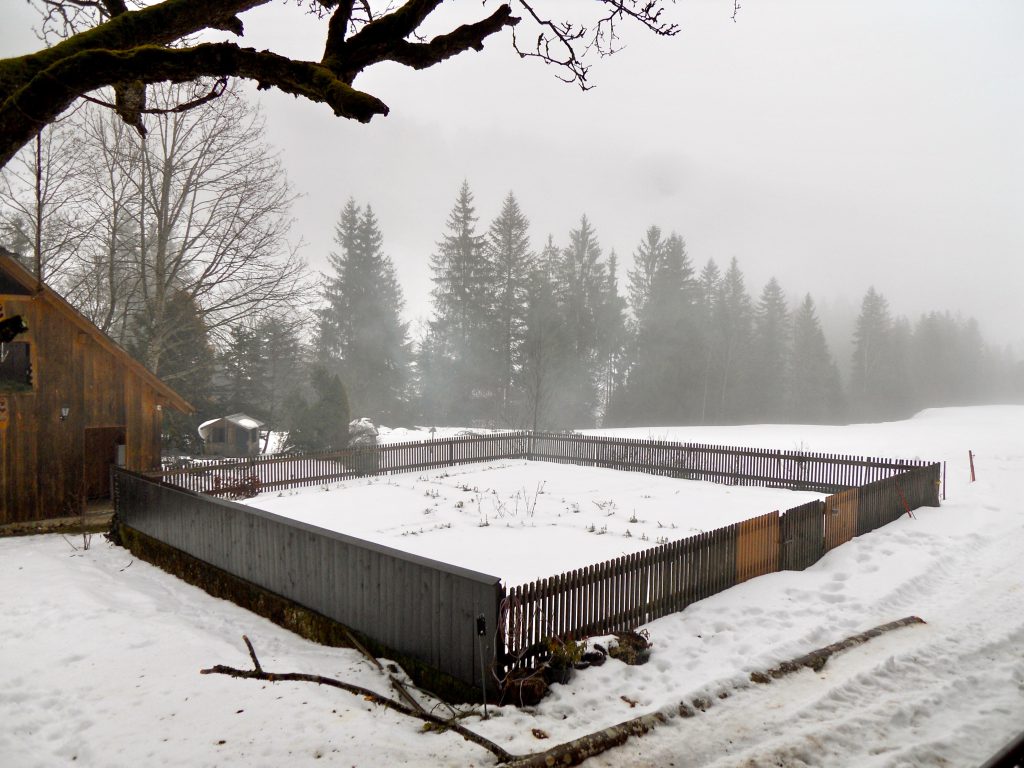
A misty day at the Fankhauser Farm: Photo by Saloma Furlong


I have been following your blog for several years, and I find your travels and research is so fascinating!
Thank you, Diane, for letting me know you are enjoying the blog postings. So glad to know there are people out there who do. Thank you for the support!
You have some valuable history in this article. Thanks for the post.
Katie, you’re welcome. I’m glad you find it useful.
Saloma, I’m so glad you were able to make this trip and to document the history and the relationships you are discovering. I had read of the Waldensian connection before but not quite as explicitly as you describe it here. Maybe further research will deepen what is apparently an oral history tradition.
Shirley, it is good to see you here.
Oral histories, by their very nature, make them difficult to research to deepen our understanding. But I keep thinking there may be ways finding existing records and looking for information that was unintentionally recorded at the time. I only wish I were twenty years younger and had the means to do this kind of research.
I hope you are missing the effects of Stella… we are still in the midst of a blizzard up here in the north country.
Your blog today reminds me of the weaving of thread. So many different strands interwoven to become one cloth. Whether written into history or given by word of mouth it seems to me it all has its importance. It all came together by these brave people who believed so strongly to follow Gods word rather than the churches rules. They are the fabric of what is now the Mennonite and Amish faith. I find it all so fascinating! I can not thank you enough for sharing. Whether you are Amish/Mennonite or not the history of those who came before us is so important for understanding who we are today.
Pamela, you are welcome, and I appreciate your comments more than you know. I find you have a way of imparting wisdom in few words, and as usual, they ring true here.
It is such a pleasure to write for an audience as appreciative as you and others who comment on my blog. I am so grateful for you all!
Hello Saloma:
What an interesting article about hidden places…and the link between the Waldensiens and the Swiss Brethren. “The weaving” of the Genuine and Radical Anabaptist faith is the best evidence we have of the links to the Swiss Brethren and Menno Simons and Jacob Amman etc. The extreme similarities over 300 years cannot be coincidence. It is way above and beyond genealogy and geographic links and even traditions because it discloses a “true heart” way of life that is closely linked to God and the Truth. The Waldensians and Anabaptists deliberately chose the most difficult road compared to all the rest of the world at that time and went completely against the grain because they believed in something passionately and understood it well. It is obvious that they believed in truth and freedom of the heart and soul so much they were even willing to die for it. The testimonies and letters in the Martyr’s Mirror are vivid evidence of the true pure freedom that linked the Waldensians and the Mennonite and Amish.
If we are in a quiet place and analyze our deepest hearts desires I believe that we hear that very exact same still small voice that spoke to our foreparents which tells us that we too can be more free and true than even those in the world that are much more intellectual and more educated, because even with all the brutal flaws our foreparents were absolutely and extremely devoted to God AND they were NOT much part of the world or the worldly.
It is true that “Fear of God is the beginning of Wisdom”! Peace only comes after embracing the truth and even the famous Martin Luther King only expressed part of the truth. This is precisely why I (from a Mennonite family) personally feel such a kinship with the Amish. “It is what it is” and it cannot be denied. We are Blessed with a “Goodly Heritage” and what peace and joy it is to discover truth in our pilgrimage in this upside down world we live in. The more we discover “The Truth” the more free we become.
PS: give my best to David.
Best Regards;
Delmer B. Martin
Hello Saloma:
What an interesting article about hidden places…and the link between the Waldensiens and the Swiss Brethren. “The weaving” of the Genuine and Radical Anabaptist faith is the best evidence we have of the links to the Swiss Brethren and Menno Simons and Jacob Amman etc. The extreme similarities over 300 years cannot be coincidence. It is way above and beyond genealogy and geographic links and even traditions because it discloses a “true heart” way of life that is closely linked to God and the Truth. The Waldensians and Anabaptists deliberately chose the most difficult road compared to all the rest of the world at that time and went completely against the grain because they believed in something passionately and understood it well. It is obvious that they believed in truth and freedom of the heart and soul so much they were even willing to die for it. The testimonies and letters in the Martyr’s Mirror are vivid evidence of the true pure freedom that linked the Waldensians and the Mennonite and Amish.
If we are in a quiet place and analyze our deepest hearts desires I believe that we hear that very exact same still small voice that spoke to our foreparents which tells us that we too can be more free and true than even those in the world that are much more intellectual and more educated, because even with all the brutal flaws our foreparents were absolutely and extremely devoted to God AND they were NOT much part of the world or the worldly.
It is true that “Fear of God is the beginning of Wisdom”! Peace only comes after embracing the truth and even the famous Martin Luther King only expressed part of the truth. This is precisely why I (from a Mennonite family) personally feel such a kinship with the Amish. “It is what it is” and it cannot be denied. We are Blessed with a “Goodly Heritage” and what peace and joy it is to discover truth in our pilgrimage in this upside down world we live in. The more we discover “The Truth” the more free we become.
PS: give my best to David.
Best Regards; Delmer B. Martin
My name is Debbie Ellis. My maiden name is Funkhouser. Been working on my family tree since 2009. Christen Fankhauser b.) 1661 is my 7th. Great-Grandfather. I really would appreciate ANY information and especially any photos you might have of Christen and his family. I live in Knightsville, Clay Co.Indiana USA. Any info on his parents and anybody else in the family. Thank you ever so much for your time on helping me out.